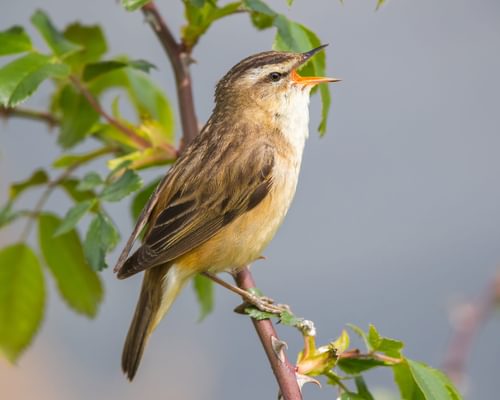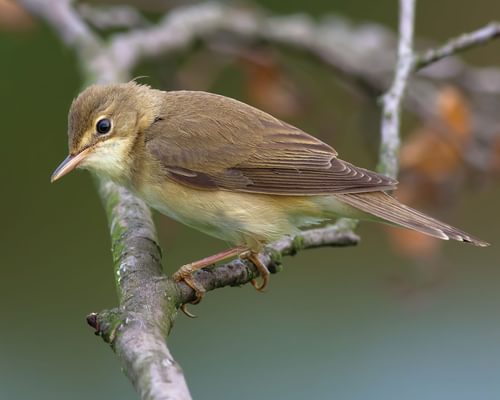Common Reed-warbler
Acrocephalus scirpaceus
Visual Identification
Appearance
The Common Reed-warbler is a small, slender bird with uniform warm brown upperparts and pale buff underparts. It has a long, pointed brownish-grey bill, a faint pale eyebrow, and a rounded head profile.
There is little difference between males and females. Their legs are dark grey, which helps to distinguish them from the similar Marsh Warbler, which has flesh-coloured legs.
Juveniles are similar to adults but may appear slightly more rufous on the upperparts.
Size
Length
12.5cm to 14cm
Wingspan
17cm to 21cm
Weight
10g to 15g
Colours
Males and females have similar plumage
Primary Colour
Brown
Secondary Colour
Buff White
Beak Colour
Brown
Leg Colour
Brown Grey
Habitat and Distribution
Habitats
Woodland
Garden
Wetland
Coastal
Urban
Farmland
Grassland
Desert
Tundra
Rainforest
Mountain
Savanna
Distribution
Common Reed-warblers are found across Europe, western Asia, and parts of North Africa. They inhabit dense reed beds, marshes, and other wetland areas with tall vegetation near water bodies.
During the breeding season, they are widespread in Europe, including the UK. In winter, they migrate to sub-Saharan Africa, with some populations travelling as far as South Africa.
Any reedbed environment, even those with just a few simple strands of reeds and rushes, attracts reed warblers in spring and summer, and they can be found in the largest concentrations across southern England, particularly East Anglia and along the south coast. In recent years, breeding has spread to parts of Scotland.
Elevation Range
Up to 1,400 meters
Climate zones
Temperate, Subtropical
Distribution Map
This map gives you a rough idea of where you might spot a Common Reed-warbler. The coloured areas show countries where these birds have been seen.
A few things to keep in mind:
- Birds might not be everywhere in the coloured areas, for example, they may be present around the coast of that country
- Where birds live can change with seasons and available food
- This map is quite simple - it doesn't show exact locations
We're working on making our maps even better! Soon, we hope to show you:
- More detailed maps for bigger countries, including state and region
- How birds move around during different seasons
Distribution by Region
Behaviour and Ecology
Bird Attributes
This feature is in beta. We'd love your feedback to improve it!
Share your thoughtsBird Attributes Explained
Our bird attributes system rates various aspects of a bird's capabilities on a scale of 0-100, based on data from field observations, scientific studies, and expert knowledge.
Attribute Categories:
- Agility: Manoeuvrability, speed, and grace in flight or movement.
- Strength: Physical power, often correlating with size and hunting abilities.
- Adaptability: Ability to thrive in various environments or changing conditions.
- Aggressiveness: Territorial behaviour and assertiveness, particularly during breeding seasons.
- Endurance: Stamina, often seen in migration patterns or foraging behaviours.
Understanding the Ratings:
- 0-20: Very Low
- 21-40: Low
- 41-60: Average
- 61-80: High
- 81-100: Very High
Remember, these attributes are relative to other bird species and don't necessarily indicate superiority.
Hover over the icon next to each attribute for more information.
Tap the icon next to each attribute for more information.
Agility
Reflects the bird's manoeuvrability, speed, and grace in flight or movement.
The Common Reed-warbler displays remarkable agility, adeptly climbing and hopping through dense reed beds. Their ability to manoeuvre in tight spaces and hang upside down or sideways whilst foraging demonstrates exceptional dexterity.
Strength
Indicates the bird's physical power, often correlating with size and hunting abilities.
As a small bird weighing only 10-15 grams, the Common Reed-warbler has limited physical strength. However, they possess sufficient strength to weave intricate nests and navigate through reeds, which requires some muscular capability.
Adaptability
Represents the bird's ability to thrive in various environments or changing conditions.
These birds show high adaptability, evidenced by their ability to mimic up to 40 other bird species and adjust their nests to changing water levels. Their successful colonisation of various wetland habitats across Europe and Asia further supports their adaptability.
Aggressiveness
Measures the bird's territorial behaviour and assertiveness, particularly during breeding seasons.
Common Reed-warblers are generally not aggressive birds. They become more territorial during breeding season, with males singing to establish territories, but they don't exhibit notably aggressive behaviour compared to many other bird species.
Endurance
Reflects the bird's stamina, often seen in migration patterns or foraging behaviours.
The Common Reed-warbler demonstrates impressive endurance, particularly during migration. Their ability to fly non-stop for up to 500 km (310 miles) and complete long-distance migrations from Europe to sub-Saharan Africa indicates substantial stamina for their size.
Diet
The Common Reed-warbler primarily feeds on insects and their larvae, including flies, beetles, and small moths. They forage by gleaning prey from reeds and other vegetation, often hanging upside down or sideways to reach food items.
In autumn, their diet may occasionally include berries, including currants, elder, cherry and dogwood. Termites, aphids, and mosquitoes are eaten on wintering grounds.
Behaviour
Common Reed-warblers are agile and active birds, often seen climbing and hopping through dense reed beds.
They are generally secretive but become more visible during the breeding season when males sing from exposed perches. These birds are typically solitary outside the breeding season.
Vocalisation
The Common Reed-warbler's song is a distinctive, rhythmic series of harsh, chattering notes interspersed with mimicry of other bird species. It often includes a repeated 'chrrr-chrrr-chrrr' sound.
The song can be heard day and night during the breeding season, helping to identify these otherwise elusive birds.
Nesting & Breeding
Breeding occurs from May to August. During this time, males establish territories and attract females through song. Pairs are monogamous.
Nests are deep cups woven between reed stems or other vertical plants, usually over water. Females lay 3-5 pale green eggs with dark speckles.
Incubation lasts about 11-12 days, and the female primarily incubates the chicks. Both parents feed the chicks, which fledge after 10-12 days but continue to receive parental care for another 1-2 weeks.
Conservation and Status
Global Conservation Status
While the Common Reed-warbler is currently listed as Least Concern, it faces threats from habitat loss due to drainage of wetlands and changes in water management practices.
Climate change may also affect its breeding and wintering grounds, potentially impacting population numbers in the future.
Birdwatching Tips
- Listen for their distinctive song in reed beds during spring and summer
- Look for movement in dense vegetation near water bodies
- Observe early morning or late evening when they are most active
- In the UK, visit wetland reserves from April to September for the best chances of spotting them
Additional Information
Quick Facts
Other names:
Eurasian Reed-warbler
Family:
AcrocephalidaeAverage Lifespan
2 to 3 years
Max Lifespan
16.9 years [4]
Predators
Main predators include birds of prey such as Sparrowhawks and Hobbies, as well as mammals like weasels and rats that can access nests in reed beds.
Did You Know?
- Common Reed-warblers can mimic the calls of up to 40 other bird species.
- They can suspend their nests between reed stems, adjusting them as water levels change.
- These birds can fly non-stop for up to 500 km (310 miles) during migration.
Similar Birds
References
- 1 2
website: BirdLife International. 2019. Acrocephalus scirpaceus (amended version of 2017 assessment). The IUCN Red List of Threatened Species 2019: e.T22714722A155436305.
View source - 3
report, 2015: EBCC
- 4
website, 2010: Fransson et al., EURING list of longevity records for European birds
View source
Share Your Feedback
We value your opinion! Let us know what you think about this bird page.

